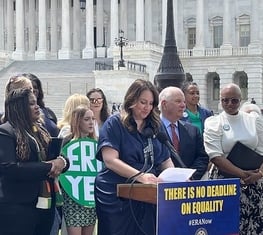Representing Middle Eastern and North African Citizens in the Census
In 2020, when it was time for my family to fill out the Census, we could only check one box in the race category: white. My family is Libyan-American, and if you saw us, you wouldn’t consider us white. Nor do millions of Arab Americans around the country consider themselves white — though this was not always the case. Recent changes to how to the Standards for Maintaining, Collecting and Presenting Federal Data on Race and Ethnicity will expand the minimum categories for self-identification, but the fight to achieve this change has been long-running.
Stay Updated
Keep up with news around the Census and other aspects of our democracy by joining our email list!
The History of Arabs, Asians, and Proximity to Whiteness
The history of Arab Americans' identity advocacy began in the early twentieth century, when Arab American immigrants advocated against being categorized as Asian. This was largely in response to discriminatory laws like the Naturalization Act of 1870, which did not allow people of Asian or Native American descent to become citizens, and the 1882 Chinese Exclusion Act, which limited immigration and prevented Asians from citizenship.
As a response to these racist and discriminatory policies, early Arab American communities separated themselves from the Asian racial category and wanted to be categorized as white. They hoped that in doing so, they would receive the protections that proximity to whiteness would afford them, particularly eligibility for citizenship.
In 1909, Lebanese-born police officer George Shishim from Venice, California, came before a court with his naturalization petition. Despite being a resident of Los Angeles for 25 years, his eligibility came down to whether Shishim was considered of Chinese-Mongolian ancestry because he was born in Lebanon, which is in Asia. At the time, an “Arab identity” disqualified someone from being considered white.

Syrian-Americans in Boston, 1909
In response, Shishim appealed to Judge George Hutton on account of his Christian identity,arguing, “If I am a Mongolian, then so was Jesus, because we came from the same land.” At the time, Islam was treated as an ethno-racial identity. Similarly, Christianity was seen as a hallmark of whiteness, giving Arab Christian immigrants an advantage over their Muslim counterparts. Thus, Judge Hutton allowed Shishim to be legally considered white because of his Christianity.
It would not be until a district court ruling in 1944 that Arab Muslims were also considered legally white and thus eligible to become naturalized citizens. In contrast, Asian Americans could not become eligible for citizenship until the 1952 Walter-McCarran Act nullified all previous Asian-exclusion laws.
As a result, Arabs have had to select the “white” category when filling out the US Census. As a result, they've become a historically undercounted and “hard-to-count” community.
One important way to remedy this issue is to include a Middle Eastern or North African (MENA) ethnic category on the decennial census. Since the 1990s, organizations like the Arab American Institute have advocated for the inclusion of a MENA category in the census, which would allow the federal government to capture relevant demographic data about Arab Americans accurately. Such data would be relevant to how districts are redrawn after apportionment and how federal funds are allocated.
Reform & Recent Changes
Reforming any part of the census is often a multi-year effort. Changes like this occur by reforming the Office of Management and Budget’s (OMB) definitions for race and ethnicity for US federal agencies’ data collection, including for the Census Bureau. While extensive research and testing for including a MENA category occurred during the Obama administration, it stalled during the Trump administration. It was taken up again in 2021 under the Biden administration as part of the president’s Executive Order committed to advancing racial equity.
In March of 2022, LWVUS joined partner organizations asking the OMB to revise standards for federal data on race and ethnicity, which, among other recommendations, called for the addition of the Middle Eastern or North African ethnic category. Then, in 2023, OMB published a Federal Register notice calling for public comments. LWVUS submitted another set of comments, highlighting the problem of MENA peoples’ inability to accurately indicate their ethnicity on government forms and the barrier it poses to equity and representation.

New OMB Standards are Published to Include MENA
At the end of March 2024, the OMB announced that new federal standards for collecting data would now include the MENA category. This means that in the 2030 Census, Arab Americans will finally have the option to select a category representing their heritage. While this is an important feat that will ensure more accurate federal demographic data collection, there is still work to be done to ensure the data collected reflects not only the ethnic makeup of the MENA community but also its racial diversity.
Arab Americans have been an integral part of American society for decades. Because of the federal government’s racist practices and discrimination against Asian Americans, early Arab Americans found themselves diminishing their own identities to fit into a conception of whiteness that centered on religion.
We cannot fault these early immigrants for making do with the existing laws, particularly in the social and political contexts in which they lived. Aligning themselves with whiteness could be understood as a band-aid solution to a more insidious problem perpetuated by the US government during that time.
As the undercount of MENA-identifying Americans went on, it became clear to Arabs and advocates that the lack of data about their communities was hampering their access to federal resources and the required data to determine district mapping. We won’t know the full effects of the OMB’s new rule until the completion of the next decennial census in 2030. Still, we can hope that it will offer a clearer picture of what the Arab American community looks like and bring about equitable consideration in federal policymaking.
In the meantime, you can look ahead to Census Day 2030 and stay tuned for more information about the League’s work to improve the census for all Americans.
The Latest from the League
The League submitted comments to the Management and Budget Office (OMB) regarding its proposed updates to the federal government’s race and ethnicity data collection standards. The outcome of this comment opportunity will update the questions that respondents see on the US Census and other forms of government data collection. LWVUS also signed onto partner comments to amplify how the proposed changes would impact numerous racial and ethnic communities in the US.
The League supports the Khalid Jabara and Heather Heyer National Opposition to Hate, Assault, and Threats to Equality (Jabara-Heyer NO HATE Act)
The League urged Congress to oppose an appropriations amendment that would exclude undocumented immigrants from the congressional apportionment calculation after each census.
Sign Up For Email
Keep up with the League. Receive emails to your inbox!
Donate to support our work
to empower voters and defend democracy.






